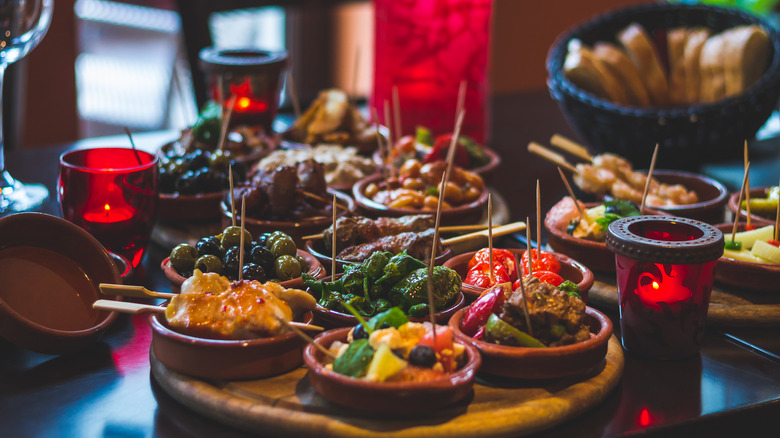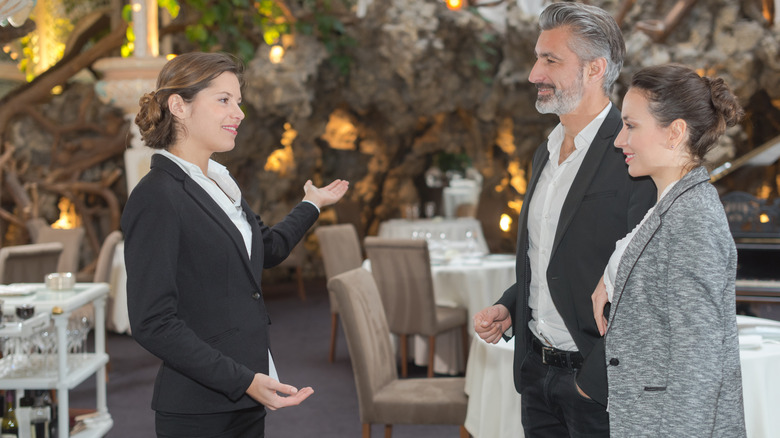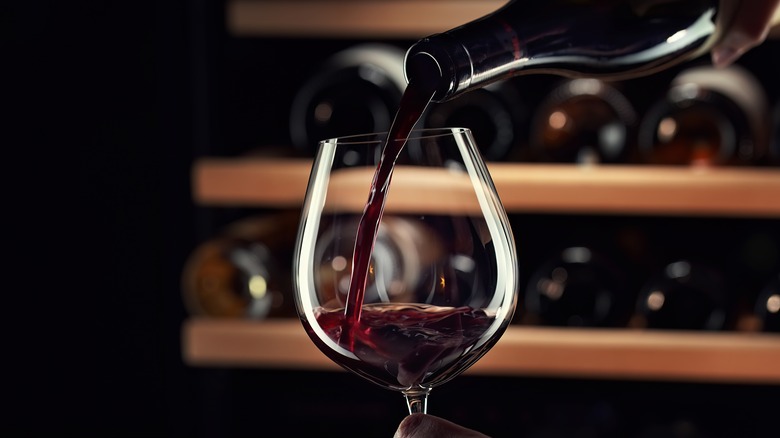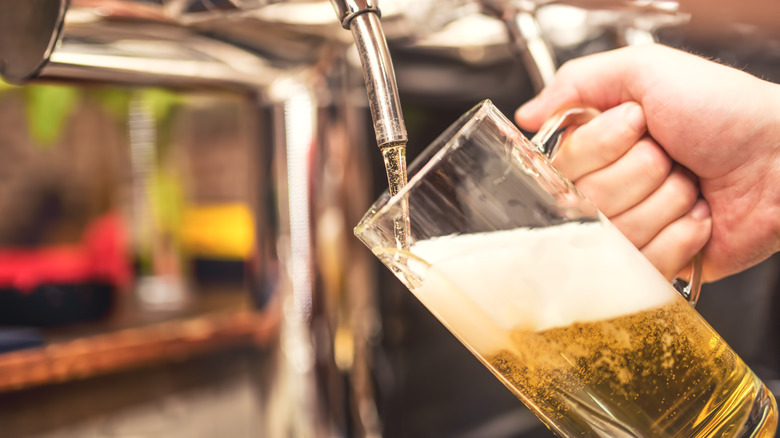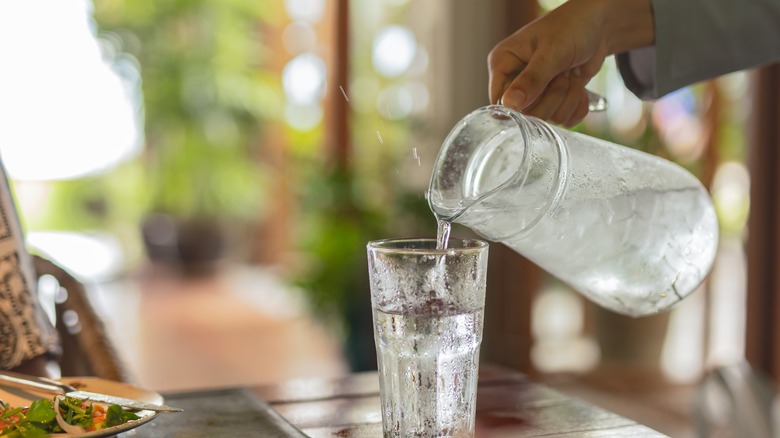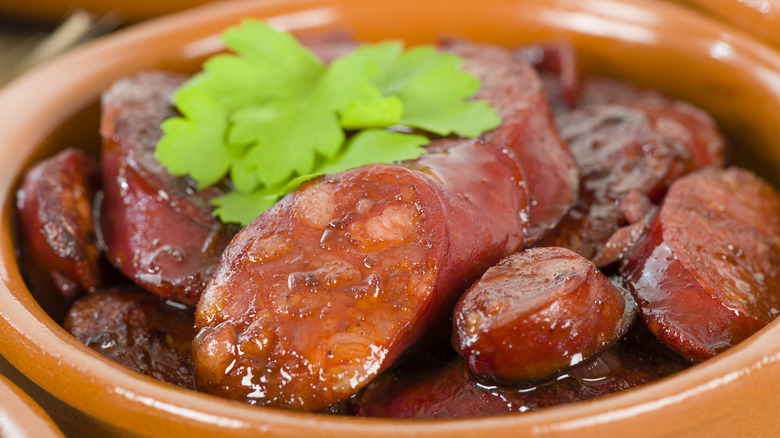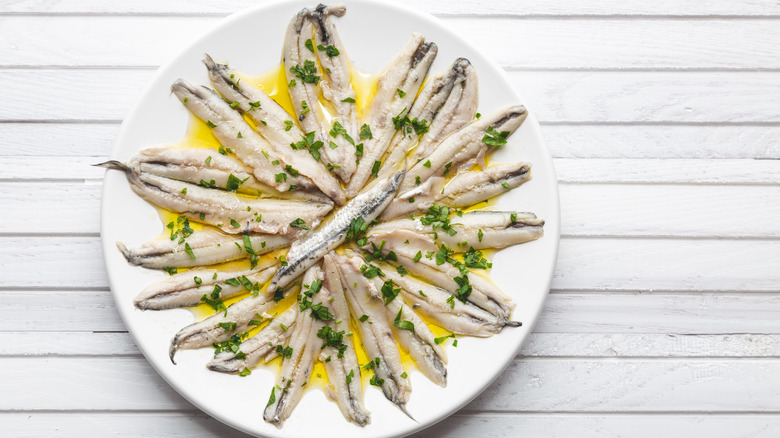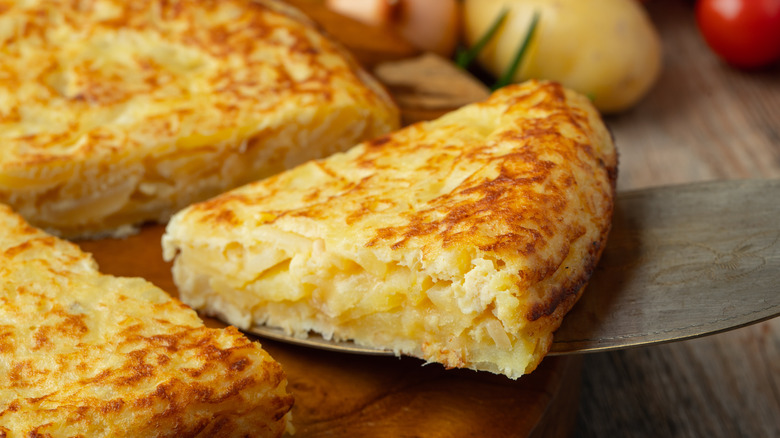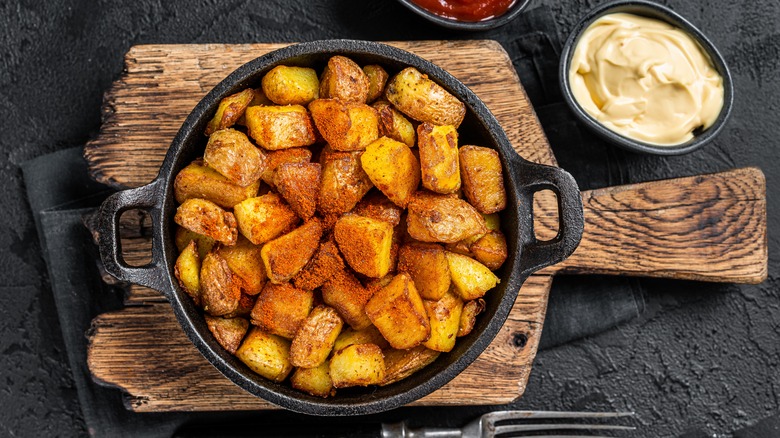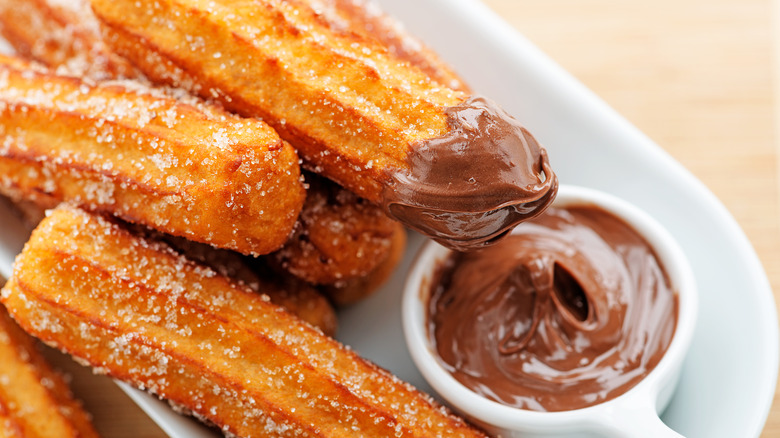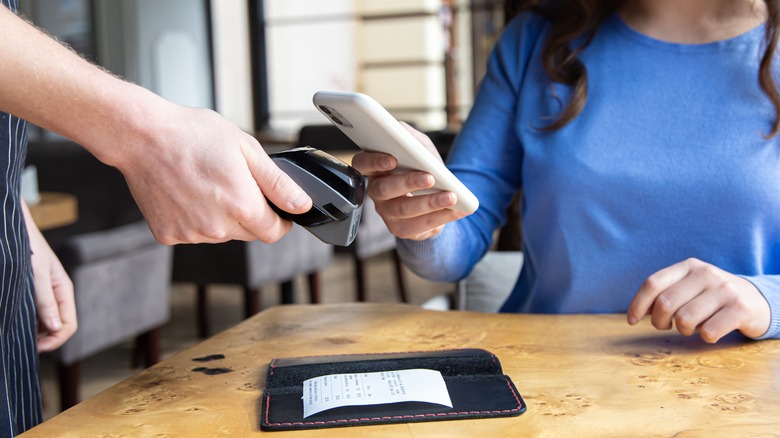Essential Words And Phrases To Know At A Spanish Tapas Joint
Spain's delicious cuisine and the intriguing world of tapas have enchanted food lovers across the globe. The delightful concept of ordering a table full of small plates with delectable food has made tapas a popular dining option far beyond the shores of Spain.
If you are planning a meal at a Spanish tapas restaurant, learning some important words and phrases will help you interact with the staff and result in a more immersive experience. From your arrival at the restaurant to your final "adios" after your feast, having a few Spanish phrases at hand will help you feel more confident and have an authentic Spanish dining experience.
Whether you are heading to bustling Barcelona or visiting a new tapas restaurant in your city, these Spanish expressions will set you up to fully embrace the culture of tapas and enjoy your culinary adventure.
It doesn't matter if you're a seasoned tapas connoisseur or embarking on your first Spanish gastronomic journey; learning these essential words and phrases will elevate your dining experience and leave a lasting impression on those around you.
Saying hello
On arrival at the tapas restaurant, you may be welcomed by the staff with the phrase "bienvenida" if you are alone or "bienvenidos" if you are with a group of people. This means "welcome" and is a friendly way for an owner or staff to greet you at their establishment.
How you respond may depend on the time of day. Unlike in English, where we use "hello" all day, in Spain, they have time-specific greetings (via FluentU). If it is morning, the most suitable phrase is "buenos dias" which means "good day" or "good morning." You should not use this phrase after midday.
As the day progresses, you should use the phrase "buenas tardes" which means "good afternoon." This greeting is used from midday until early evening.
Once the sun has set, the best option is "buenas noches," which literally means "goodnight" but is used to mean "good evening."
If in doubt, you can use the word "hola" (the 'h' is silent) at any time of day for a general "hi," and it can be used in both formal and informal scenarios.
Whatever version you choose to say, the staff will appreciate your effort to learn their language and will welcome you warmly.
How are you?
Once you have arrived at the tapas restaurant, a member of staff may ask you how you are by saying, "como esta?" This is the formal version of the phrase and should be used when addressing strangers.
This is the perfect opportunity to try out your Spanish and engage in a brief conversation that shouldn't be too overwhelming. If you wish to give a simple and polite reply, you can say "estoy bien, gracias," which means "I am fine, thank you." This phrase shows gratitude but will not oblige you to continue chatting.
If you feel comfortable and wish to continue the conversation, you could say "muy bien, ¿y usted?" which means "very well, and you?"
If you do not know the staff, you will likely want to use one of the above phrases to be polite and engage with them. However, in other situations, you may wish to convey that you are not feeling great, in which case you can say, "no tan bien," which means "not so good."
The aim of this introductory conversation with the staff is to make you feel at ease, and they will be delighted to see you making an effort, even if your Spanish isn't perfect the first time. Don't be afraid to try out these phrases at the beginning of your meal, hopefully giving you confidence going forward.
Table for two, please
In many restaurants in Spain, customers will simply choose a free table and sit at it. However, if you want to practice the phrases you've been learning, it's worth asking a staff member for a table. A simple way to ask is to say "una mesa para dos, por favor," which means "a table for two, please." Obviously, you can substitute whichever number applies to your party size. Alternatively, if there is a particular table you would prefer to sit at, you can point to or stand at the table and ask, "¿está libre esta mesa?" meaning "is this table free?"
You may wish to go further and request a table in a particular area. A table near the window would be "una mesa cerca de la ventana," while if you prefer to dine outside, you can ask for "una mesa afuera."
If you have a child in your party and need a high chair, you can ask for "una trona para el niño, por favor." Be aware that many restaurants in Spain will not have high chairs available, especially outside of the big cities and tourist hotspots. You may need a backup plan if you are traveling to Spain with small children.
Ordering your food
Once you are seated at your table, it's time for the fun part — deciding what to order! By nature, a tapas restaurant will have a lot of options for you to choose from, so you may have questions about the food. If you need to call your server for help, you can catch their eye and raise your hand slightly in the air. You can also say "perdón," which means "excuse me." Never snap your fingers or whistle to get the waiting staff's attention, as this would be considered rude.
If you are vegetarian, let the server know before you order so they can advise you which dishes are suitable. The phrase "soy vegetariano(a)" means "I am a vegetarian," and "soy vegano(a)" means "I am a vegan." Like many words, they both change the ending from "o" to "a" if the speaker is female.
While Spanish tapas restaurants will sell many vegetable dishes, they may not all be cooked in a meat-free environment, so it is essential to check with your server before ordering.
If your server asks "¿Están listos para pedir?" they are asking if you are ready to order. You can reply with "Si, gracias. Quisiera un(a) ... por favor."
Let's go on to look at what items you might want to order from the menu.
Menu items -- wine
Spain is renowned for its exceptional wines, and visiting a tapas restaurant is the perfect opportunity to savor the rich and diverse wine culture. Most restaurants will have a wine list, or you can simply ask your server for a house wine (vino de la casa). This is often a well-chosen option that pairs perfectly with a variety of tapas dishes.
Once you know which wine you want, you can say "me gustaría un vino tinto" if you want a robust red wine or "me gustaría un vino blanco" for a crisp white. Spain also produces some great rose wines, so if you are in the mood for something light and fruity, try asking for "un vino rosado."
Generally speaking, staff in Spanish restaurants will be very knowledgeable about wine, so don't hesitate to ask for guidance in choosing a bottle to accompany your meal.
Menu items -- beer
If beer is your drink of choice, you may already know that "cerveza" is the Spanish word for beer. But it's not as simple as just asking for a "cerveza." You will then be asked what type you want, and this may throw you off your stride if you're not prepared. Most Spanish bars and restaurants will have a couple of draught beers available, and you can either order a small one, "caña," or a large "doble."
If you would prefer a bottled beer, you can ask for "una botella" and then the name of the brand. Spanish restaurants often have a selection of popular local and international beer brands available, so you should be able to find something to suit your taste and complement your food.
If you are looking for a non-alcoholic beer in a Spanish restaurant, you are in luck, as Spaniards drink more low or no alcohol beer than any other country (via Vine Pair.) There will likely be a few options to choose from, so ask for a "cerveza sin alcohol" and enjoy a refreshing beer without the threat of a hangover.
Menu items -- other drinks
If you are ordering water for the table, be aware that unless you specify, you will be brought a bottle of mineral water. If you want to order tap water instead, ask for "agua de grifo." For a bottle of sparkling water, you can use "agua con gas."
If you are craving a refreshing orange juice with your meal, ask for "un zumo de naranja" or simply "un zumo de frutas" to find out what fruit juices they have available.
After your meal — if you are in the mood for a hot drink to conclude — there are a few options you may wish to ask for. If you are looking for black tea, ask for "te negro," whereas green tea would be "te verde." A popular Spanish version is "te con limon" which is tea infused with a slice of lemon.
For coffee, you will likely already be familiar with many varieties, such as espresso and cappuccino. To order a white coffee, ask for "cafe con leche," and a decaf is "un descafeinado."
Menu items -- meat
The beauty of tapas is that it gives you a chance to sample a variety of different foods rather than choosing just one main course. For the carnivores out there, that means a feast of meat dishes to choose from. If you are a beef lover, you will want to look for "carne de res" on the menu. A popular dish that often contains a mixture of beef and pork is albondigas en salsa – meatballs in a piquant tomato sauce.
You will find lots of chicken or "pollo" dishes on a tapas menu, cooked in many different ways. Alitas de pollo are spicy chicken wings, similar to American buffalo chicken, and will pair perfectly with a rich garlicky aioli.
Ham frequently appears on Spanish tapas menus, and croquetas de jamon are a great option. These crispy morsels are filled with a delicious mixture of ham and bechamel sauce, which oozes out when you bite into them.
As a meat eater, you can't really dine in a tapas restaurant and not order some chorizo. One dish that showcases this iconic cured Spanish sausage is chorizo al tinto. This mouthwatering dish consists of chorizo cooked in red wine, infusing it with rich, delightful flavors.
Meat items -- fish
With almost 5,000 kilometers of coastline, seafood holds a prominent and cherished place in Spanish cuisine, and this is reflected in the variety of fish served in tapas restaurants.
If the only tuna you have ever tasted is canned, you should really treat yourself to "filete de atún" in a Spanish restaurant. It tastes nothing like its tinned counterpart, seared on both sides but still pink in the middle; it is much more meaty than you would expect.
Another classic Spanish fish dish is boquerones en vinagre — fresh anchovies in vinegar. These silvery beauties are famous across Spain and are a great way to start your meal or eat alongside other dishes.
Any fish lover in a tapas restaurant should be ordering some "gambas" — prawns. One dish that stands out as a must-try is "gambas pil pil." Featuring succulent prawns sizzling in a spicy, garlicky oil, the smell of this dish alone with have your mouth watering.
If you are a fan of deep-fried calamari, you should take the opportunity to try squid served in a different way in a tapas restaurant. Calamari a la plancha showcases the fresh flavor of the squid by cooking it on a hot grill before seasoning simply with a squeeze of lemon and some fresh herbs.
Menu items -- eggs and cheese
Eggs and cheese appear frequently on tapas menus, often in the same dish. Use your tapas dining experience as a chance to try some new dishes with these ingredients.
"Huevos rotos" literally translates as "broken eggs" and can take several forms, but usually consists of a fried egg and ham, served on top of french fries or roasted potatoes. It is a delicious Spanish comfort dish that can be eaten at any time of the day.
Tortilla de patatas is a Spanish omelet that features thinly sliced potatoes bound together by fluffy eggs. This beloved Spanish dish can be served warm or cold and is a staple on tapas menus.
For cheese enthusiasts, "croqueta de queso" are not to be missed. A crispy shell filled with a mixture of cheeses and cooked until it melts, every bite is a gooey delight. If you would prefer a lighter cheese option, "ensalada de cabra" is a wonderful goat cheese salad that will provide a refreshing contrast to some of the more filling dishes on the menu.
Menu items -- vegetables
The Spanish are known for growing fresh, vibrant vegetables, and this love of veg can also be seen on tapas menus. There will be plenty of vegetable dishes to choose from, whether you are following a plant-based diet or simply wanting to accompany your other tapas with some healthy side options.
It is customary to enjoy a plate of "aceituna" or olives at the beginning of the meal. You may wish to order these at the same time you choose your drinks, meaning you can savor their salty goodness while you peruse the menu.
A staple of Mediterranean cuisine, "tomate" play a central role in many tapas dishes. A lovely way to enjoy them is to order "pan con tomate" which translates as "bread with tomatoes." This humble dish showcases the brightness of the tomatoes by combining them with fresh herbs and olive oil, then serving them on some crispy toasted bread.
Champinones gratinados is a great dish to try if you are a mushroom lover. Mushrooms are filled with garlic, herbs, and breadcrumbs, topped with cheese, and then baked in the oven. The result is a comforting, umami mixture that will delight your tastebuds.
No tapas meal would be complete without an order of "patatas." Patatas bravas is a classic side dish containing roasted potatoes with a spicy tomato sauce. They make a great accompaniment to meat dishes but can also be enjoyed as a dish on their own.
Menu items -- desserts
Since many tapas dishes are healthy and filled with fresh vegetables, you may want to treat yourself to a dessert to finish your meal. You will find a delicious selection of sweet dishes on the menu and should be able to find the perfect end to your tapas feast.
A classic Spanish dessert is churros, which are Spanish donuts. They are made from a dough consisting of flour and water that is then deep-fried in oil until golden and crispy. As in the popular "churros con chocolate," they can then be dipped in melted chocolate to create an indulgent dessert.
Creme caramel is a beloved dessert that can be found on every tapas menu. Known simply as "flan," it features a sweet, smooth custard with a hint of vanilla. The hero of the dish is the gorgeous layer of caramel that tops the custard, creating a heavenly combination of sticky caramel and silky custard with every spoonful.
If you're looking for a cheesecake to finish your meal, you should ask for a "tarte de queso." This Spanish dessert can come in many variations and is often topped with fresh fruit coulis. It has a lighter and fluffier texture than New York cheesecake, with a delicious crunchy base.
Finishing up
After savoring a satisfying array of tapas, it is time to wrap up your dining experience. To ask for the check, you can simply say "la cuenta, por favor," or you can ask"¿nos trae la cuenta, por favor?" which means, "can you give us the check, please?" Most restaurants will accept both card and cash, you can let them know which you prefer with "pagare en efecivo" for cash and "pagare con tarjeta de credito" for card.
Once you have settled the check and are ready to leave, you can thank the staff by saying "muchas gracias," which means "thank you very much." As you go, the standard way to say goodbye would be "adios," or you could add in "que tengas un lindo día" for "have a nice day."
Showing the staff and owners gratitude for the meal you have had will leave a favorable impression and create a positive relationship if you decide to return in the future.

